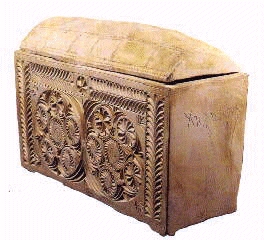Joseph Caiaphas, High Priest (18 C.E.-36 C.E)


Joseph Caiaphas was the high priest of Jerusalem who, according to Biblical accounts, sent Jesus to Pilate for his execution.
As high priest and chief religious authority in the land, Caiaphas had many important responsibilities, including controlling the Temple treasury, managing the Temple police and other personnel, performing religious rituals, and--central to the passion story--serving as president of the Sanhedrin, the Jewish council and court that reportedly considered the case of Jesus.
The high priest had another, more controversial function in first-century Jerusalem: serving as a sort of liaison between Roman authority and the Jewish population. High priests, drawn from the Sadducean aristocracy, received their appointment from Rome since the time of Herod the Great, and Rome looked to high priests to keep the Jewish populace in line. We know from other cases (such as one incident in 66 C.E.) that Roman prefects might demand that high priests arrest and turn over Jews seen as agitators.
Caiaphas was the son-in-law of Annas, high priest from 6 to 15 C.E. and head of a family that would control the high priesthood for most of the first century. Annas is also mentioned in Biblical accounts. It is possible that he, as a high priest emeritus, might have served at the side of Caiaphas in the Sanhedrin called to resolve the fate of Jesus.
Although little is known of Caiaphas, historians infer from his long tenure as high priest, from 18 to 36 C.E., that he must have worked well with Roman authority. For ten years, Caiaphas served with Roman prefect Pontius Pilate. The two presumably had a close relationship. It is likely that Caiaphas and Pilate had standing arrangements for how to deal with subversive persons such as Jesus.
Caiaphas's motives in turning Jesus over to Pilate are a subject of speculation. Some historians suggest that he had little choice. Others argue that Caiaphas saw Jesus as a threat to the existing religious order. He might have believed that if Jesus wasn't restrained or even executed that the Romans might end their relative tolerance of Jewish institutions.
High priests, including Caiaphas, were both respected and despised by the Jewish population. As the highest religious authority, they were seen as playing a critical role in religious life and the Sanhedrin. At the same time, however, many Jews resented the close relationship that high priest maintained with Roman authorities and suspected them of taking bribes or practicing other forms of corruption.
In the year 36 C.E., both Caiaphas and Pilate were dismissed from office by Syrian governor, Vitellius, according to Jewish historian Josephus. It seems likely that the cause of their dismissal was growing public unhappiness with their close cooperation. Rome might have perceived the need for a conciliatory gesture to Jews whose sensibilities had been offended by the two leaders. Josephus described the high priests of the family of Annas as "heartless when they sit in judgment."
Unlike other Temple priests, Caiaphas, as a high priest, lived in Jerusalem's Upper City, a wealthy section inhabited by the city's powers-that-be. His home almost certainly was constructed around a large courtyard.
Archaeologists discovered in 1990 in a family tomb in Abu Tor, two miles south of Jerusalem, an ossuary, or bone box, containing on its side the name of Joseph Caiaphas, written in Aramaic. The ossuary is assumed to be genuine.


Pontius Pilate was the Roman prefect (governor) of Judea, a subprovince of Syria, who ordered the crucifixion of Jesus.
As prefect, Pilate commanded Roman military units, authorized construction projects, arranged for the collection of imperial taxes, and decided civil and criminal cases.
During his ten-year tenure as prefect, Pilate had numerous confrontations with his Jewish subjects. According to Jewish historian Josephus, Pilate's decision to bring into the holy city of Jerusalem "by night and under cover effigies of Caesar" outraged Jews who considered the images idolatrous. Jews carried their protest to Pilate's base in Caesaria. Pilate threatened the protesters with death, but when they appeared willing to accept martyrdom he relented and removed the offending images. Again according to Josephus, Pilate provoked another outcry from his Jewish subjects when he used Temple funds to build an aqueduct. It seems likely that at the time of the trial of Jesus, civil unrest had again broken out in Jerusalem.
Pilate's lack of concern for Jewish sensibilities was accompanied, according to Philo writing in 41 C.E, by corruption and brutality. Philo wrote that Pilate's tenure was associated with "briberies, insults, robberies, outrages, wanton injustices, constantly repeated executions without trial, and ceaseless and grievous cruelty." Philo may have overstated the case, but there is little to suggest that Pilate would have any serious reservations about executing a Jewish rabble-rouser such as Jesus.
Although Pilate spent most of his time in the coastal town of Caesaria, he traveled to Jerusalem for important Jewish festivals. While in Jerusalem, he stayed in the praetorium, which--there is a debate about this--was either a former palace of Herod the Great or a fortress located at the northwest corner of the Temple Mount. (Josephus reported that Pilate resided at the palace.)
Christian accounts of the trial of Jesus suggest either that Pilate played no direct role in the decision to execute Jesus (Peter), or that he ordered the crucifixion of Jesus with some reluctance (Mark) or with great reluctance (Luke, John). Many historians attribute these accounts to efforts by early Christians to make their message more palatable to Roman audiences. It is clear that prefects had a variety of options available for dealing with a potential source of trouble such as Jesus. These options included flogging, sending the matter back to the Sanhedrin, or referring the case to Herod Antipas, ruler of Galilee.
Given what is known about Pilate's concern with crowd control, it is hard to imagine that he would not have willingly acceded to a request from high Jewish officials to deal harshly with anyone who proclaimed himself "King of the Jews." Pilate undoubtedly knew that past messianic claims had led to civil unrest. It seems likely that he would have been eager to end the potential threat to the existing order presented by the subversive theology of Jesus. The form of execution used--crucifixion-- establishes that Jesus was condemned as a violator of Roman, not Jewish, law.
Pilate's repeated difficulties with his Jewish subjects was the apparent cause of his removal from office in 36 C.E. by Syrian governor Vitellius. Following his removal from office, Pilate was ordered to Rome to face complaints of excessive cruelty. He was exiled in Vienne, France.
